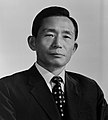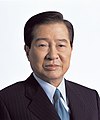Portal:South Korea
 |
환영합니다! / Welcome To The South Korea Portal!  South Korea, officially the Republic of Korea (ROK), is a country in East Asia. It constitutes the southern part of the Korean Peninsula and borders North Korea along the Korean Demilitarized Zone; though it also claims the land border with China and Russia. The country's western border is formed by the Yellow Sea, while its eastern border is defined by the Sea of Japan. South Korea claims to be the sole legitimate government of the entire peninsula and adjacent islands. It has a population of 51.96 million, of which roughly half live in the Seoul Capital Area, the ninth most populous metropolitan area in the world. Other major cities include Busan, Daegu and Incheon. The Korean Peninsula was inhabited as early as the Lower Paleolithic period. Its first kingdom was noted in Chinese records in the early 7th century BCE. Following the unification of the Three Kingdoms of Korea into Silla and Balhae in the late 7th century, Korea was ruled by the Goryeo dynasty (918–1392) and the Joseon dynasty (1392–1897). The succeeding Korean Empire (1897–1910) was annexed in 1910 into the Empire of Japan. Japanese rule ended following Japan's surrender in World War II, after which Korea was divided into two zones: a northern zone occupied by the Soviet Union, and a southern zone occupied by the United States. After negotiations on reunification failed, the southern zone became the Republic of Korea in August 1948, while the northern zone became the communist Democratic People's Republic of Korea the following month. In 1950, a North Korean invasion began the Korean War, which ended in 1953 after extensive fighting involving the American-led United Nations Command and the People's Volunteer Army from China with Soviet assistance. The war left 3 million Koreans dead and the economy in ruins. The authoritarian First Republic of Korea led by Syngman Rhee was overthrown in the April Revolution of 1960. However, the Second Republic was incompetent as it could not control the revolutionary fervor. The May 16 coup of 1961 led by Park Chung Hee put an end to the Second Republic, signaling the start of the Third Republic in 1963. South Korea's devastated economy began to soar under Park's leadership, recording the one of fastest rises in average GDP per capita. Despite lacking natural resources, the nation rapidly developed to become one of the Four Asian Tigers based on international trade and economic globalization, integrating itself within the world economy with export-oriented industrialization. The Fourth Republic was established after the October Restoration of 1972, in which Park wielded absolute power. The Yushin Constitution declared that the president could suspend basic human rights and appoint a third of the parliament. Suppression of the opposition and human rights abuse by the government became more severe in this period. Even after Park's assassination in 1979, the authoritarian rule continued in the Fifth Republic led by Chun Doo-hwan, which violently seized power by two coups and brutally suppressing the Gwangju Uprising. The June Democratic Struggle of 1987 ended authoritarian rule, forming the current Sixth Republic. The country is now considered among the most advanced democracies in Continental and East Asia. (Full article...) Selected article - The division of Korea began on August 15, 1945 when the official announcement of the surrender of Japan was released, thus ending the Pacific Theater of World War II. During the war, the Allied leaders had already been considering the question of Korea's future following Japan's eventual surrender in the war. The leaders reached an understanding that Korea would be liberated from Japan but would be placed under an international trusteeship until the Koreans would be deemed ready for self-rule. In the last days of the war, the United States proposed dividing the Korean peninsula into two occupation zones (a U.S. and Soviet one) with the 38th parallel as the dividing line. The Soviets accepted their proposal and agreed to divide Korea. It was understood that this division was only a temporary arrangement until the trusteeship could be implemented. In December 1945, the Moscow Conference of Foreign Ministers resulted in an agreement on a five-year, four-power Korean trusteeship. However, with the onset of the Cold War and other factors both international and domestic, including Korean opposition to the trusteeship, negotiations between the United States and the Soviet Union over the next two years regarding the implementation of the trusteeship failed, thus effectively nullifying the only agreed-upon framework for the re-establishment of an independent and unified Korean state. With this, the Korean question was referred to the United Nations. In 1948, after the UN failed to produce an outcome acceptable to the Soviet Union, UN-supervised elections were held in the US-occupied south only. Syngman Rhee won the election, while Kim Il Sung consolidated his position as the leader of Soviet-occupied northern Korea. This led to the establishment of the Republic of Korea in southern Korea on 15 August 1948, promptly followed by the establishment of the Democratic People's Republic of Korea in northern Korea on 9 September 1948. The United States supported the South, the Soviet Union supported the North, and each government claimed sovereignty over the whole Korean peninsula. On 25 June 1950, North Korea invaded South Korea in an attempt to re-unify the peninsula under its communist rule. The subsequent Korean War, which lasted from 1950 to 1953, ended with a stalemate and has left Korea divided by the Korean Demilitarized Zone (DMZ) up to the present day. (Full article...)Selected image The Gold crown from Seobongchong Tumulus (Korean: 서봉총 금관; Hanja: 瑞鳳塚金冠; RR: Seobongchong geumgwan; MR: Sŏbongch'ong kŭmgwan), National Treasure of South Korea No. 339, is a gold crown of Silla origin that is now housed at the Gyeongju National Museum. More did you know -
In the news
This is a Good article, an article that meets a core set of high editorial standards.
HL Anyang (Korean: HL 안양) is a professional ice hockey team based in Anyang in Gyeonggi Province, South Korea. It is one of the founding and current members of the Asia League Ice Hockey (ALIH). Formed in 1994, it is the oldest professional ice hockey team in South Korea. The Halla Group contributes three billion won annually to run the club. At its inception the team was based in Mok-dong, Seoul and named the Mando Winia. In 1998 the team took the name of Mando's parent company, Halla. After the collapse of the Korean Ice Hockey League in 2003, they were the only team to survive. They joined four Japanese teams to create the new Asia League Ice Hockey. In 2005, the team moved to its current hometown of Anyang, where it plays its home games at the Anyang Ice Arena. After two years of finishing in fifth place, they became the first non-Japanese team to finish first in the regular season in 2008–09. However, they failed to defeat the Nippon Paper Cranes in the semi-finals. In the following season, Halla again finished in first and won the semi-final and final series giving them their first play-off series win and first Asia League Championship. The club captured their second AL title after the league cancelled the championship final due to the earthquake in Japan. Asia League announced Halla and Tohoku Free Blades as the co-champions. In 2022, the team rebranded as HL Anyang. (Full article...)General images -The following are images from various South Korea-related articles on Wikipedia.
Did you know (auto-generated)
WikiProjectsSee WikiProject Korea for collaborating on South Korea topics, and more broadly, on all things Korea-related. South Korea topics
CategoriesAdministrative divisions of South Korea
Related portalsEast Asia Associated WikimediaThe following Wikimedia Foundation sister projects provide more on this subject:
Web resources
SourcesDiscover Wikipedia using portals |























































